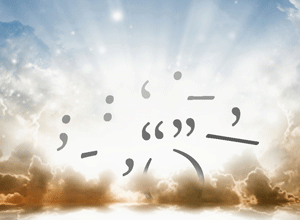
Johnny ran outside, looked at the petunias, then went into the kitchen. Outside again, he played with Spot for a minute, then went for a cookie.
When the screen door slammed, Mom gave him that exasperated look. “Johnny, how many times have I told you to quit running in and out? If you can’t behave, how do you expect to get into Heaven?”
“That’s easy,” he said. “I’ll just keep slammin’ them gold gates ’til God says either get in or get out.”
Some punctuations are like Johnny. They don’t know whether they want to be inside or outside the quotation marks. If exceptions leave us confused about the rules, we’re left guessing whether they should be in or out.
Periods and Commas: Unless you’re British, writing for the United Kingdom, always put them inside the quotation marks. Wasn’t that easy? No exceptions.
Question Marks: Put them inside the marks unless the quotation is a statement, not a question. Example: Did the teacher say, “Jefferson was our first president”?
Colons and Semicolons: Always put them outside the quotation marks.
Em-dash: The long dash goes inside the quotation marks to indicate interrupted speech. Example: Sally said, “If you weren’t so quick to pass judgm—” (Watch the direction of the curly quotes, because software often wants to turn them the wrong way after an em-dash.) “But I’m not judging,” Bill said.
Rarely, you might need to enclose a narrative fragment inside a line of dialogue. That can be neatly achieved by using the em-dash around the narrative, outside the quotation marks. Example: “I believe I will find it”—he opened the drawer—“right here.”
Punctuation usage can be easy. Know the few simple rules that cover 90 percent of the situations. Then, if you understand the reason for any exceptions, you’ll be in Punctuation Heaven.
For more information about punctuation, Click Here.



